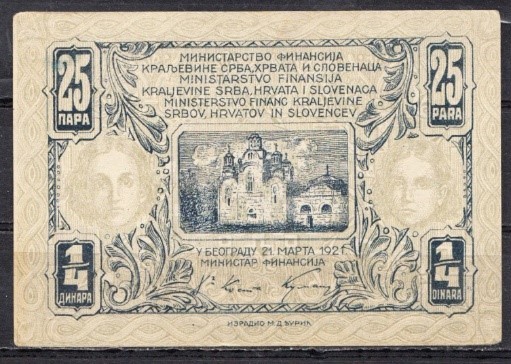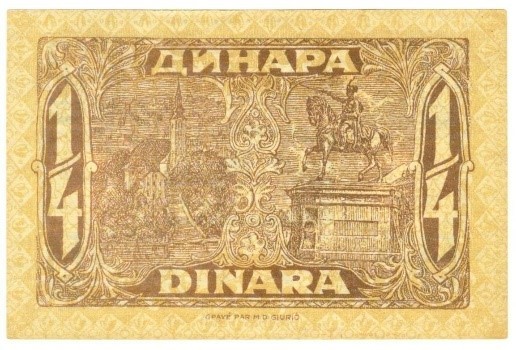The 25-par banknote from 1921 is the smallest paper banknote in the Kingdom of SHS, the Kingdom of Yugoslavia, post-war Yugoslavia and the Republic of Serbia. Its dimensions are 92x62 mm. A total of 199,127,376 banknotes out of the planned 200 million were printed in the printing houses in Novi Sad and Zagreb and they were put into circulation on June 14, 1921. On November 31, 1921, King Alexander the First promulgated the Law on the Printing of the 1/4 dinar Banknote and the Replacement of the Austro-Hungarian Bank's 1, 2, and 10 Crown Banknotes, which, apart from his own, also contains the signatures of Dr. Lazar Marković, Minister of Justice, and the President of the Ministerial Council, Nikola Pašić.

Obverse of the 25-par banknote

The reverse of the 25-par banknote
Palčica is paper money issued by the state in 1921, whose value is 25 paras or 1/4 dinar. Romania also has its Palčica among the banknotes. Namely, in 1917, the Central Bank of Romania issued a 10-ban note and it is considered one of the smallest in the world. Its dimensions are 27x38 mm and its size corresponds to a postage stamp. The reason for the issuance of such a small banknote lies in the shortage of raw materials for the production of metal money that prevailed during the First World War.
The decision to produce a 25-para note was made on March 3, 1921. The reasons for its issuance are also known - the insufficient amount of 25-para metal money that was in circulation since December 1920 and the replacement of the 1, 2 and 10 kroner banknotes of the Austro-Hungarian Bank. The law of December 31, 1921 on the printing of the 1/4 dinar banknote and the replacement of the 1, 2 and 10 kroner banknotes of the Austro-Hungarian Bank was signed and announced to the public by Aleksandar I Karađorđević. The law was published in the Official Gazette - supplement no. 238 - XXXII from 25.10.1922. Apart from the King, the Law was also signed by the Minister of Justice, Dr. Lazar Marković, and the President of the Council of Ministers, Nikola Pašić, who put the state stamp on it.
The then Minister of Finance, Dr. Kosta Kumanudi, was authorized to begin the production of this banknote at the printing house, that is, the institution that will make the most favorable offer. It is stated that the offer will refer to the production of 200 million pieces with a nominal value of 50 million dinars. The two most favorable printing houses from Zagreb and Novi Sad were chosen. The Ministry of Finance received a total of 199,127,376 banknotes, 140 million from Zagreb and 59,127,376 from Novi Sad. The banknote was put into circulation on June 14, 1921.
There is no official data on when this banknote was withdrawn from circulation. The only thing that is reliably known is that Minister Kumanudi issued an order to withdraw from circulation the rest of the 1, 0.25 and 0.50 dinar state money by September 30, 1927 and replace it with coins, and that after that date they will lose each important. Not a single forgery of the 1/4 dinar banknote was recorded, which can be explained by its low value. Making a fake would probably cost more than its value. These banknotes do not have a watermark and are not numbered.
Their detailed description is given in the Decision of the Minister of Finance of June 18, 1921. The decision of the Minister of Finance stated: "The surface of the front and back of the banknote is covered with various ornaments, on its face in a greenish-gray color, and on the reverse in a chamois color." On the face of the banknote there are two children's heads, a drawing of the Gračanica monastery, its value and the full name of the Ministry of Finance". Additionally, under the drawing of the Gračanica monastery, there is an inscription - IN BELGRADE MARCH 21, 1921 and the signature of the Minister of Finance, Dr. Kosta Kumanudi. In the middle, near the bottom of the face of the banknote, its author M. D. Đurić (Zemun 1894 - Zagreb 1945), painter and professor at a school in Zagreb, is listed. On the reverse side of the banknote, covered with base ornaments in a dark color in a rectangle of 80x51 mm, there are nominal value markings and drawings of Bled and the monument of ban Jelačić in Zagreb. In the middle of the lower edge of the reverse, the name and surname of the banknote's author are repeated in French.


